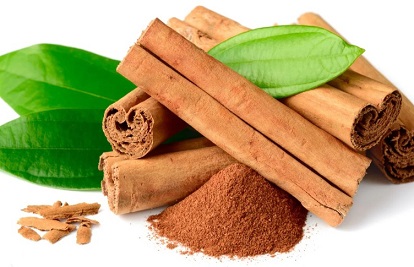Medical News: Italian Study Shows That Cinnamaldehyde From Cinnamon Is An Effective Adjuvant For COVID-19 Prevention And Treatment!
Nikhil Prasad Fact checked by:Thailand Medical News Team Nov 22, 2023 1 year, 4 months, 6 days, 4 hours, 7 minutes ago
Medical News: The devastating impact of the COVID-19 pandemic, driven by the SARS-CoV-2 virus, has spurred intensive research efforts globally. Among the myriad investigations, a groundbreaking study conducted at the University of Ferrara in Italy has unveiled the potential of cinnamaldehyde, the active compound in cinnamon, as a compelling adjuvant for preventing and mitigating the inflammatory responses associated with severe COVID-19. This
Medical News report delves into the intricate details of the study, shedding light on the scientific underpinnings and implications of cinnamaldehyde's role in the context of COVID-19 prevention.

Thailand
Medical News had also previously covered on the merits of Cinnamon and its phytochemicals in COVID-19 treatment protocols.
https://www.thailandmedical.news/news/covid-19-herbs-german-american-study-shows-that-cinnamaldehyde-from-cinnamon-is-a-good-supplement-with-dexamethasone-for-treating-covid-19
https://www.thailandmedical.news/news/covid-19-herbs-study-finds-that-galangal-cinnamon-spice-mixture-blocks-coronavirus-infection-pathway-through-inhibition-of-sars-cov-2-mpro
https://www.thailandmedical.news/news/breaking-news-plant-based-compound-dicoumarol-emerges-as-promising-post-exposure-prophylactic-for-omicron-variant-of-sars-cov-2
https://www.thailandmedical.news/news/cinnamon-the-natural-remedy-for-flu-infections-and-beyond
It should be noted that when Cinnamon was proposed by various experts to be a possible adjuvant for treatment protocols in COVID-19 in the early part of the pandemic, various American social media platforms and mainstream news outlets along with dubious ‘fact-checkers’ from the United States and the United Kingdom simply dismissed these calls as simply fake news. The general public has yet to take necessary actions against many of these garbage entities and individuals.
Understanding the Inflammatory Pathways in COVID-19
The study set out to address a crucial gap in our understanding of the pharmacological approaches targeting virus-induced inflammation, a hallmark of severe respiratory conditions associated with COVID-19. The cytokine storm, characterized by elevated levels of pro-inflammatory cytokines such as interleukin-1 beta (IL-1β) and interleukin-6 (IL-6), plays a pivotal role in the systemic inflammation observed in COV
ID-19 patients. The researchers aimed to explore the efficacy of cinnamaldehyde in reducing this cytokine storm.
Patient Enrollment and Key Findings
A cohort of 53 COVID-19 patients, hospitalized for respiratory failure, became the focal point of the study. This diverse group consisted of 39 males and 13 females, with an average age of 65.0 ± 9.8 years. The research revealed a significant increase in plasma levels of IL-1β and IL-6 in COVID-19 patients compared to non-COVID-19 pneumonia patients, providing a clear indication of the presence of a cytokine storm. Importantly, isolated mononuclear cells from SARS-CoV-2 infected patients exhibited an increased release of pro-inflammatory cytokines upon stimulation.
Cellular Mechanisms - Macrophages and Lung Cells
To unravel the cellular mechanisms contributing to the pro-inflammatory response, the researchers employed in vitro cell models. Macrophages emerged as crucial players in mediating the cytokine storm, while lung cells were found to support SARS-CoV-2 replication. This nuanced understanding highlighted the necessity for targeted interventions that address both aspects of the viral infection - inflammation and replication.
Cinnamaldehyde Intervention
The study demonstrated that cinnamaldehyde administration significantly reduced SARS-CoV-2-related inflammation by inhibiting NLRP3-mediated IL-1β release in mononuclear cells and macrophages. Additionally, cinnamaldehyde exhibited antiviral effects by reducing viral replication in epithelial cells. Notably, aerosol-administered cinnamaldehyde effectively reduced IL-1β release in an in vivo lung-inflammatory model. These findings illuminate the multifaceted impact of cinnamaldehyde on both the inflammatory and replicative aspects of SARS-CoV-2 infection.
Discussion - Implications for COVID-19 Treatment
The in-depth exploration of cinnamaldehyde's potential leads to a discussion on its implications for COVID-19 treatment. Beyond its role as a co-adjuvant preventive treatment for COVID-19, complementing vaccination efforts, cinnamaldehyde's potential as a dietary supplement holds promise for reducing viral-induced inflammation more broadly. The study underscores the need for innovative therapeutic approaches that address the intricate interplay between inflammation and viral replication.
Exploring the Molecular Basis - NLRP3 Inflammasome
The study further delves into the molecular basis of cinnamaldehyde's action, focusing on the NLRP3 inflammasome - a key regulator of inflammatory responses. Activation of the NLRP3 inflammasome is implicated in various diseases, including viral infections. Cinnamaldehyde's ability to modulate NLRP3 activation, as observed in previous studies on renal inflammation and rheumatoid arthritis, positions it as a promising therapeutic approach for viral-induced lung inflammation. This nuanced understanding of the molecular pathways sheds light on the specificity and targeted impact of cinnamaldehyde on the inflammatory cascade.
Clinical Implications and Future Directions
Chronic inflammation stands as a significant hallmark of pulmonary diseases, emphasizing the need to address the pro-inflammatory cytokine storm induced by pathogens. The study's findings on cinnamaldehyde's potential applications extend beyond COVID-19, encompassing various forms of pneumonia caused by different pathogens. This broader perspective positions cinnamaldehyde as a promising dietary supplement to mitigate pro-inflammatory effects induced by pulmonary infections.
The study also raises questions about the broader application of cinnamaldehyde in human respiratory diseases caused by various pathogens. While the focus is on COVID-19, the potential of cinnamaldehyde as a therapeutic agent for a spectrum of respiratory conditions warrants further investigation. The researchers acknowledge the need for additional studies to explore the broader application of cinnamaldehyde and its efficacy in different respiratory disease scenarios.
Conclusion
In conclusion, the University of Ferrara's study provides a comprehensive analysis of cinnamaldehyde's potential role in preventing and alleviating COVID-19-induced inflammation. The intricate details of patient enrollment, cellular mechanisms, and molecular pathways offer a nuanced understanding of how cinnamaldehyde operates in the context of SARS-CoV-2 infection. The dual action of cinnamaldehyde in reducing pro-inflammatory cytokines and inhibiting viral replication positions it as a promising candidate for further exploration in COVID-19 treatment and potentially other respiratory diseases. As the scientific community continues to unravel the complexities of COVID-19, cinnamaldehyde emerges as a beacon of hope, offering a targeted and multifaceted approach to address the intricate interplay between viral infection and inflammation.
The study findings were publsihed in the peer reviewed Journal of Inflammation.
https://journal-inflammation.biomedcentral.com/articles/10.1186/s12950-023-00364-9
For the latest
Medical News, keep on logging to Thailand Medical News.
